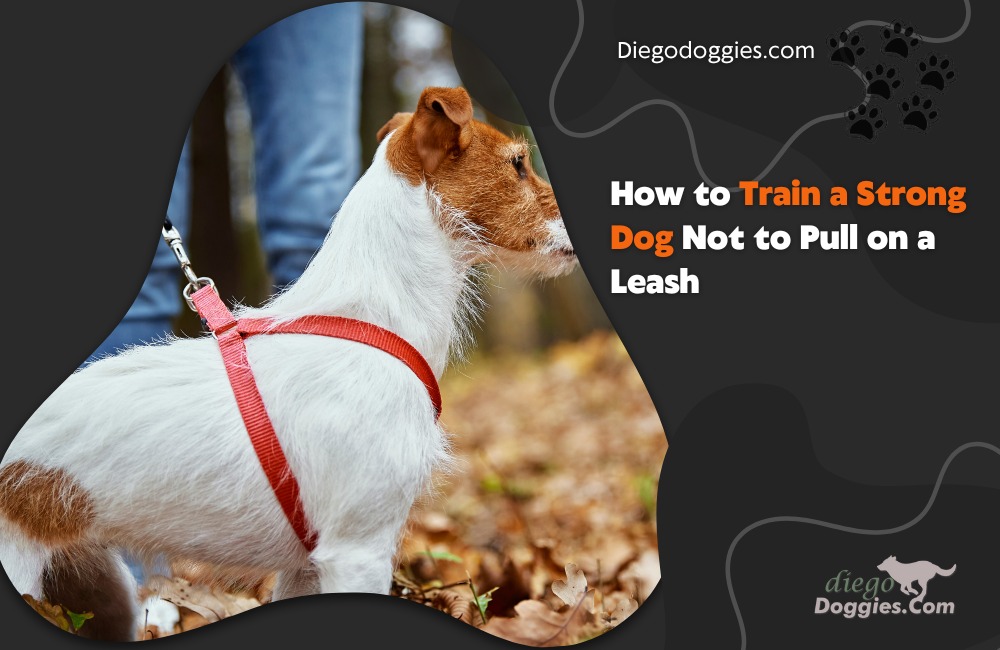For many dog owners, taking their dogs for a walk is one of the highlights of the day. However, if your dog is strong and tends to pull on the leash, it can quickly become a frustrating experience.
Fortunately, there are a few simple tips that can help you train your dog not to pull on the leash. This article explains what to do:

1. What Is The Best Way To Attach A Leash To A Strong Dog- Strong Lead To Collar Or Harness?
When you have a strong dog, it is important to choose the right method for attaching a leash. The best way to do this is to train your dog to respond well to both a collar and harness. That way, you will have the option of using whichever one is most comfortable for your dog at any given time.
If you are only attaching a leash to a collar, be sure to use a strong lead that will not snap if your dog pulls. And if you are using a harness, be sure to attach the leash to the front clip rather than the back clip.
By taking these precautions, you will be able to keep your strong dog safe and under control whether you are out on a walk or just playing in the yard.
2. Should You Have A Tracker Device On Your Dog’s Collar
If you are worried about your strong dog getting loose, you may want to consider attaching a tracker device to his collar. This way, you will be able to find him quickly if he happens to run off. There are a variety of tracker devices on the market, so be sure to do your research to find one that is right for you and your dog.
Read about one dog tag that links to your smartphone by clicking here.
3. How Can You Distract Other Dogs To Avoid Fights
When you are out walking your strong dog, it is important to be aware of other dogs in the area. If you see another dog approaching, try to distract your dog with a treat or toy. This will help avoid any potential fights.
And if you do happen to find yourself in a situation where there is a risk of a fight, be sure to keep a close eye on both dogs and be prepared to intervene if necessary.
Some dog owners carry a personal alarm to distract other dogs, which can be helpful if a fight starts. It will serve as a distraction for both dogs because a shrill alarm on the ground a few meters away will divert their attention from the fight.

4. Why Is It Important To Train A Strong Dog Not To Pull On A Leash
There are a few reasons why it is important to train a strong dog not to pull on the leash. First, it is a safety issue. If your dog is strong and tends to pull, he could easily break free from his collar or harness. This could lead to him getting lost or getting into a dangerous situation.
Second, it is important to be considerate of other people when you are out walking your dog. If your dog is pulling on the leash, he could easily knock someone down, especially if that person is elderly or has a disability. And finally, it is simply more enjoyable for both you and your dog if he does not pull on the leash.
By taking the time to train your dog not to pull, you will be able to enjoy walks together and create lasting memories.
5. What Are Some Methods You Can Use To Train A Strong Dog Not To Pull On A Leash
There are a variety of methods you can use to train a strong dog not to pull on the leash. One method is to stop walking whenever your dog starts to pull. This will teach him that he will not get anywhere if he pulls on the leash.
Another method is to change direction whenever your dog starts to pull. This will help disorient him and make it more difficult for him to pull.
Finally, you can try using treats or toys to distract your dog whenever he starts to pull.
6. What Are Some Common Mistakes People Make When Training A Strong Dog Not To Pull On A Leash
One common mistake people make when training a strong dog not to pull on the leash is using too much force. This can be counterproductive as it can cause your dog to become scared or aggressive. Another mistake is not being consistent with the training.
If you only work on this issue occasionally, your dog is unlikely to make much progress. Finally, some people try to use a choke chain or prong collar to train their dog not to pull. However, these devices can be very harmful if used incorrectly, so it is best to avoid them altogether.
7. What Are Some Tips For Preventing Your Strong Dog From Pulling On The Leash
There are a few things you can do to prevent your strong dog from pulling on the leash. First, make sure he is getting plenty of exercises. A tired dog is less likely to pull on the leash. Second, keep training sessions brief.
If you try to train for too long, your dog is likely to get bored or frustrated. And finally, do not forget to give your dog plenty of praise and rewards when he does well. This will help him associate good behavior with positive reinforcement.
With these tips in mind, you will be well on your way to preventing your strong dog from pulling on the leash.
8. How Long Does It Usually Take Training A Strong Dog Not To Pull On A Leash
If you have a strong dog that likes to pull on its leash, are some things you can do to help train them not to do this. First, you need to decide whether you want to attach the leash to a collar or a harness.
If your dog is particularly strong, a harness may be a better option as it will distribute the force of their pulling more evenly across their body.
You may also want to consider using a tracker device on your dog’s collar so you can keep an eye on their whereabouts at all times. Finally, if you are walking near other dogs, try to distract your dog with treats or toys so they do not start a fight.
9. What Are The Pros And Cons Of Using A Harness Versus A Collar For Attaching A Lead To A Strong Dog
Here are some PROS to consider when you are making the decision to use a harness or a collar:
- A harness evenly distributes the pulling force around the dog’s body, making it more comfortable for them and preventing injuries.
- A harness can be easier to put on and take off than a collar, especially for dogs who are strong or wiggly.
- Harnesses provide more control over a strong or energetic dog than a collar does, making them ideal for dogs who need additional training.
- Harnesses are less likely to slip off than collars, making them a safer option for dogs who pull or lunge while on walks.
- Some harnesses have features such as reflective strips or handles that can make walking a strong dog safer and easier.
- Harnesses that fit properly do not restrict a dog’s movement or breathing as some collars can.
- Dogs who wear harnesses are less likely to develop neck injuries than those who wear collars.
- There are many different styles and types of harnesses available, so it is easy to find one that is a good fit for both the dog and the owner’s needs.
Here are some CONS to consider when you are making the decision to use a harness or a collar:
- You may need to spend more time training your dog to walk with a harness, as they may not be used to it.
- A collar can provide more control over a strong dog than a harness, as you can attach the lead directly to their neck.
- A harness may put unnecessary stress on your dog’s back and shoulders, which could lead to health problems later.
- If your dog is particularly strong, it may be able to pull out of a harness more easily than a collar.
- A harness can restrict your dog’s movement more than a collar, which may be uncomfortable for them.
- A collar is more comfortable for dogs than a harness, as they are not accustomed to wearing one.
- Harnesses can be more expensive than collars, so you will need to factor that into your budget.
- Some dogs simply do not like wearing a harness and will become agitated or stressed when one is put on them.
In the end, it is up to you to decide whether a harness or collar is the best option for your strong dog because you know the temperament of your dog better than anyone else. Consider all the pros and cons before making your decision.
Conclusion
There is no one-size-fits-all answer to the question of whether you should use a harness or collar for your strong dog. Both have their own set of pros and cons that you will need to consider before deciding. The best option for you will depend on your individual circumstances and what you feel is best for your dog.
Related Contents
- 14 Basic Dog Obedience Training Commands for Dogs
- 14 Easy Ways to Exercise Your Dog: Fun and Effective Methods
- 8 Therapy Dog Training Tips: How to Train Your Dog
- Choosing The Best Training Treats For Your Puppy
- Dog Walking Tips- 18 Helpful Tips to Walk Your Dog
- Eight Dog Breeds That Are Good With Horses
- Dog Training Cost? A Comprehensive Guide
- Make Crate Training Easy for Your Puppy


1 thought on “How to Train a Strong Dog Not to Pull on a Leash”